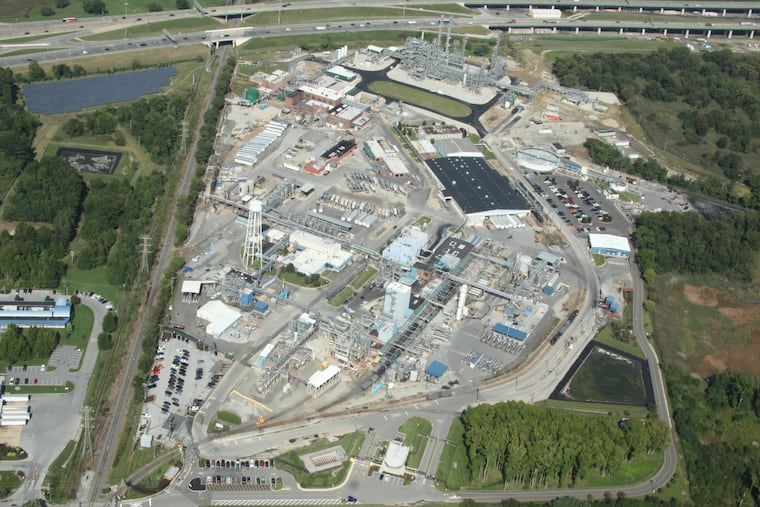25 ‘serious’ violations at U.K. chemical maker’s Delaware River plant
The findings relate to a Nov. 25 ethylene oxide leak that closed the neighboring Delaware Memorial Bridge, snarling holiday traffic on the nearby New Jersey Turnpike and I-95 at the end of the long Thanksgiving weekend.

The British chemical-maker Croda failed to take required safety measures to prevent, protect, or contain leak of explosive gas at its Atlas Point chemical plant on the Delaware River, federal regulators have found.
The findings by the U.S. Occupational Safety and Health Administration relate to a Nov. 25 ethylene oxide leak that closed the neighboring Delaware Memorial Bridge, snarling holiday traffic on the nearby New Jersey Turnpike and I-95 at the end of the long Thanksgiving weekend.
One worker was hospitalized and five more suffered symptoms of ethylene oxide exposure in the resulting accident, according to OSHA. The company and emergency responders had at first said no one was injured, then said several workers checked in with doctors just in case.
OSHA recommended Croda pay $262,548, after deducting 10 percent from the maximum penalties because the plant had a previous good record. In March, Croda was fined an additional $246,500 by the State of Delaware and ordered to conduct testing and improvements.
“We strive to foster a safe work environment that complies with all OSHA requirements,” said a statement from Croda spokesperson Cara Eaton. She said company officials were reviewing the OSHA findings “to determine our next steps."
“They risked the health of their workers," said Erin G. Patterson, director of the OSHA office in Wilmington, in a written statement. The leak “could have been prevented if the employer had taken appropriate precautions,” followed “well-known safety and health procedures,” flagged improper materials and methods used in the construction of the ethylene oxide unit, protected plant operators with a safe location from which to deal with emergencies, and properly trained workers to cope with accidents.
The accident had raised questions from nearby residents and bridge users about why a potentially dangerous new industrial facility was built on plant property next to a heavily traveled bridge, or why the state and county approved the plan.
Croda had deficient emergency action and response plans, and failed to train employees to manage ethylene oxide leaks, OSHA said. Its records showed inadequate fire protection, water deluge systems, and emergency shutdown procedures. Croda also failed with its records and procedures for helping firefighters manage an ethylene oxide leak.
The ethylene oxide unit, which was completed last summer, remains shut until the company complies with state and federally mandated improvements. The plant, which employs about 250, remains open, using ethylene oxide shipped by rail from Texas — a practice Croda had hoped to end with the new unit, which made the volatile but useful industrial material from alcohol.
“There is no restart date at present,” said Michael Globetti, spokesperson for the Delaware Department of Natural Resources and Environmental Control. He said his agency would hold a public hearing before the ethylene oxide unit can go back on line.
Croda wants the fines reduced and is negotiating with OSHA toward a civil settlement.
Among Croda’s violations alleged by OSHA, the company:
Failed to notice that contractors assembling a piping flange bolted it together wrong, used cheaper alloy bolts instead of stainless steel as required in the assembly specification, and sealed a pipe with an inappropriate gasket that could be corroded by ethylene oxide. State investigators earlier reported that a gasket failure led to the leak.
Failed to update piping and instrument diagrams, provide a hazard evaluation, firefighting instructions, ethylene oxide leak instructions, and other required procedures, making it tough for workers to understand the threat from the leak and exposing them to toxics, fire, and explosion.
Despite realizing the plant’s ethylene oxide control room “was in an area of potential toxic release,” it failed to add air sensors, protected air supplies, sealed windows and doors, appropriate personal protective equipment, an evacuation plan, and emergency procedures to protect workers who remained at the plant in an attempt to contain the leak.
Did not show that it met engineering standards for water supply, pumps, and emergency spraying. Indeed, the firefighting water supply was “undersized for a high firewater demand case.” Croda needed state and local fire department assistance to dilute the ethylene oxide to prevent it from reaching explosive concentrations.
“Failed to address the need” for an ethylene oxide leak detection system.
“Failed to address human factors” such as the “confusing displays" in the control-room instruments, “resulting in operating errors,” such as “erroneous” instructions to the firefighting system,